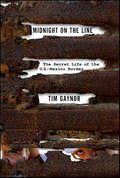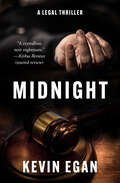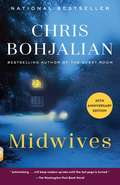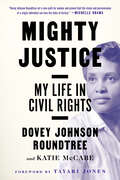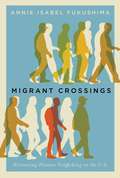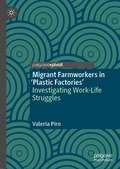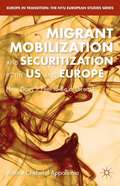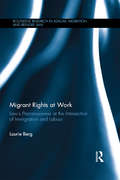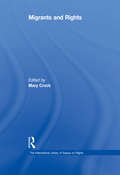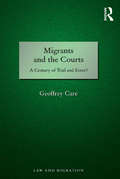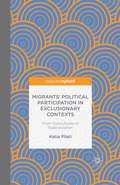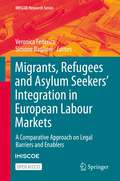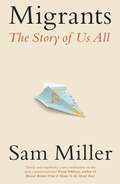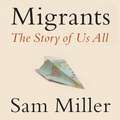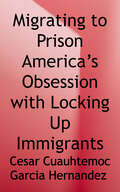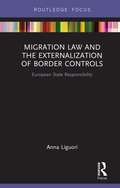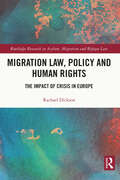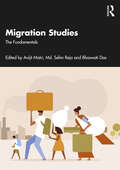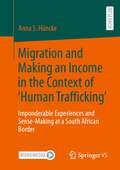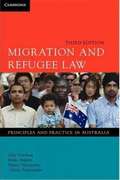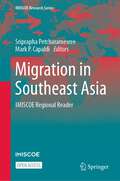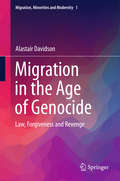- Table View
- List View
Midnight on the Line: The Secret Life of the U.S.-Mexico Border
by Tim GaynorA probing, ground-level investigation of illegal immigration and the people on both sides of the battle to secure the U.S.–Mexico borderWith illegal immigration burning as a contentious issue in American politics, Reuters reporter Tim Gaynor went into the underbelly of the border and to the heart of illegal immigration: along the 45-mile trek down the illegal alien "superhighway." Through scorpion-strewn trails with Mexican migrants and drug smugglers, he met up with a legendary group of Native American trackers called the Shadow Wolves, and traveled through the extensive network of tunnels, including the "Great Tunnel" from Tijuana to Otay Mesa, California. Along the way, Gaynor also meets Minutemen and exposes corruption among the Border Patrol agents who exchange sex or money for helping smugglers. The issue of illegal immigration has a complexity beyond any of the political rhetoric. Combining top-notch investigative journalism with a narrative style that delves into the human condition, Gaynor reveals the day-to-day realities on both sides of "the line."
Midnight: A Legal Thriller
by Kevin Egan&“Hitchcock would have loved Midnight&’s twisty, original plot. . . . A fast, fun read fueled by a clever premise and well-developed characters&” (Phillip Margolin, New York Times–bestselling author). A Kirkus Reviews Best Book of the Year New Year&’s Eve is just another night for Carol Scilingo and Tom Carroway, secretary and law clerk for Judge Canter. The holiday might have been different if single mom Carol didn&’t have her young son and aging mother to care for, or if Tom wasn&’t struggling with a gambling addiction that&’s left him deeply in debt to a loan shark. But here they are, on the last day of the year, waiting for the judge to rule on a controversial union decision so they can go home to their respective homes and watch the ball drop on TV. Only their day—and lives—take a dramatic turn when Tom finds Judge Cantor dead in his chambers. When a judge dies, the staff keep their jobs until the end of that year. Unless they want to be unemployed in a few hours, Tom and Carol will have to pretend the judge is still alive until midnight. Their plan is simple, until corruption and greed force them into a twisted conspiracy that will unearth their darkest secrets and lies . . . &“With relentless suspense, cinematic pacing and a twist around every corner, Kevin Egan creates a brand-new genre: legal thriller noir.&” —Hank Phillippi Ryan, USA Today–bestselling author &“The most bracingly original thriller of the year. Egan&’s deliciously devious novel asks and then answers the perfect question: How far would you go to keep your job?&” —Jon Land, USA Today–bestselling author
Midwives: A Novel (Vintage Contemporaries)
by Chris Bohjalian"Superbly crafted and astonishingly powerful. . . . It will thrill readers who cherish their worn copies of To Kill A Mockingbird." --PeopleWith a suspense, lyricism, and moral complexity that recall To Kill a Mockingbird and Presumed Innocent, this compulsively readable novel explores what happens when a woman who has devoted herself to ushering life into the world finds herself charged with responsibility in a patient's tragic death.The time is 1981, and Sibyl Danforth has been a dedicated midwife in the rural community of Reddington, Vermont, for fifteen years. But one treacherous winter night, in a house isolated by icy roads and failed telephone lines, Sibyl takes desperate measures to save a baby's life. She performs an emergency Caesarean section on its mother, who appears to have died in labor. But what if--as Sibyl's assistant later charges--the patient wasn't already dead, and it was Sibyl who inadvertently killed her?As recounted by Sibyl's precocious fourteen-year-old daughter, Connie, the ensuing trial bears the earmarks of a witch hunt except for the fact that all its participants are acting from the highest motives--and the defendant increasingly appears to be guilty. As Sibyl Danforth faces the antagonism of the law, the hostility of traditional doctors, and the accusations of her own conscience, Midwives engages, moves, and transfixes us as only the very best novels ever do.BONUS: This edition includes an excerpt from Chris Bohjalian's The Light in the Ruins.
Mieten und Vermieten für Dummies (Für Dummies)
by Jutta WeberOb Maklergebühr, Kaution, Renovierungsklauseln, Nebenkostenabrechnung, Mieterhöhungen, Wohnungsmängel oder Kündigung - zwischen Mieter und Vermieter gibt es genügend Themen, die für Zündstoff sorgen können. Fast jeder hat das schon einmal erlebt. Aber wer kennt schon das Mietrecht bis ins letzte Detail? Die erfahrene Anwältin Jutta Weber erläutert die Rechte und Pflichten von Mieter und Vermieter und bietet zahlreiche Checklisten und Mustervorlagen, die für Klarheit sorgen. So hilft dieses Buch, das Verhältnis zu Ihrem (Ver)Mieter so angenehm wie möglich zu gestalten und unnötige Auseinandersetzungen zu vermeiden.
Mighty Justice: My Life in Civil Rights
by Dovey Johnson Roundtree Katie McCabe&“Dovey Johnson Roundtree set a new path for women and proved that the vision and perseverance of a single individual can turn the tides of history.&” —Michelle ObamaIn Mighty Justice, trailblazing African American civil rights attorney Dovey Johnson Roundtree recounts her inspiring life story that speaks movingly and urgently to our racially troubled times. From the streets of Charlotte, North Carolina, to the segregated courtrooms of the nation&’s capital; from the male stronghold of the army where she broke gender and color barriers to the pulpits of churches where women had waited for years for the right to minister—in all these places, Roundtree sought justice. At a time when African American attorneys had to leave the courthouses to use the bathroom, Roundtree took on Washington&’s white legal establishment and prevailed, winning a 1955 landmark bus desegregation case that would help to dismantle the practice of &“separate but equal&” and shatter Jim Crow laws. Later, she led the vanguard of women ordained to the ministry in the AME Church in 1961, merging her law practice with her ministry to fight for families and children being destroyed by urban violence. Dovey Roundtree passed away in 2018 at the age of 104. Though her achievements were significant and influential, she remains largely unknown to the American public. Mighty Justice corrects the historical record.
Migrant Crossings: Witnessing Human Trafficking in the U.S.
by Annie Isabel FukushimaMigrant Crossings examines the experiences and representations of Asian and Latina/o migrants trafficked in the United States into informal economies and service industries. Through sociolegal and media analysis of court records, press releases, law enforcement campaigns, film representations, theatre performances, and the law, Annie Isabel Fukushima questions how we understand victimhood, criminality, citizenship, and legality. Fukushima examines how migrants legally cross into visibility, through frames of citizenship, and narratives of victimhood. She explores the interdisciplinary framing of the role of the law and the legal system, the notion of "perfect victimhood", and iconic victims, and how trafficking subjects are resurrected for contemporary movements as illustrated in visuals, discourse, court records, and policy. Migrant Crossings deeply interrogates what it means to bear witness to migration in these migratory times—and what such migrant crossings mean for subjects who experience violence during or after their crossing.
Migrant Farmworkers in 'Plastic Factories’: Investigating Work-Life Struggles
by Valeria PiroThis book provides a fine-grained ethnographic examination of the everyday negotiations and conflicts taking place in greenhouses and packinghouses in an agricultural district in south-eastern Italy (Sicily). In a highly competitive global scenario, driven by multinational corporations and large retailers, small and medium-sized farms largely rely on migrant labour to fill their demand for casualized, flexible and low-paid jobs. By taking the reader into the ‘plastic factories’ where the author was hired as a farmworker, this book sheds light on the struggles – around the employment contract, the wage and the body – which take place every day between employers and employees. The book contributes to broadening the understanding of the dynamics innervating food production worldwide by recognizing the pivotal role of migrant labour not only as a factor in the restructuring of global supply chains, but also as an actor shaping these processes through its own unpredictable strategies.
Migrant Mobilization and Securitization in the US and Europe: How Does It Feel to Be a Threat? (Europe in Transition: The NYU European Studies Series)
by Ariane Chebel D’appolloniaImmigrants and minorities in Europe and America have responded in diverse ways to security legislation introduced since 9/11 that targets them, labeling them as threats. This book identifies how different groups have responded and explains why, synthesizing findings in the fields of securitization, migrant integration, and migrant mobilization.
Migrant Rights at Work: Law's precariousness at the intersection of immigration and labour (Routledge Research in Asylum, Migration and Refugee Law)
by Laurie BergPublic debates about the terms of membership and inclusion have intensified as developed economies increasingly rely on temporary migrant labour. While most agree that temporary migrant workers are entitled to the general protection of employment laws, temporary migrants have, by definition, restricted rights to residence, full social protections and often to occupational and geographic mobility. This book raises important ethical questions about the differential treatment of temporary and unauthorised migrant workers, and permanent residents, and where the line should be drawn between exploitation and legitimate employment. Taking the regulatory reforms of Australia as a key case study, Laurie Berg explores how the influence of immigration law extends beyond its functions in regulating admission to and exclusion from a country. Berg examines the ways in which immigration law and enforcement reconfigure the relationships between migrant workers and employers, producing uncertain and coercive working conditions. In presenting an analytical approach to issues of temporary labour migration, the book develops a unique theoretical framework, contending that the concept of precariousness is a more fruitful way than equality or vulnerability to evaluate and address issues of temporary migrant labour. The book will be of great interest to scholars and practitioners of immigration law and employment law and policy.
Migrants and Refugees
by M. M. EbochThe images are shocking and upsetting: drowned children washing up on beaches, dozens of dead bodies being pulled out of tractor trailers, a mass of humanity penned up in detention camps and tent cities, anti-immigrant rallies characterized by fearful and hate-filled invective. Yet there are also images of refugees being embraced by ordinary citizens and welcomed into their countries, their communities, even their homes. <p><p> What to do about a growing and endemic refugee crisis and migrant labor population in an age of globalization, terrorism, and income inequality is a question with no simple answers. This volume presents the widest possible range of opinions from reputable sources across the political spectrum and encouragers readers to consider all viewpoints before formulating their own reasoned and informed perspective.
Migrants and Rights (The International Library of Essays on Rights)
by Mary CrockThe concept of the migrant as rights bearer at law is surprisingly recent and under-developed. Migrants have traditionally been seen as outsiders, persons who are in society but not yet of society. Migrants are at best invitees, ’guests’ for whom presence in a country is a privilege. This is the first of two volumes which bring together writings which trace the evolution in thinking about migrants as legal subjects and rights holders. The articles cover: issues around state sovereignty and migrants as subjects of international law; the articulation of rights; different categories of migrants; issues around health and disability. The volume also features an extended article on the proposal for an International Migrants’ Bill of Rights (IMBR) put forward by an international consortium of academics and students. A related volume Refugees and Rights is also published as part of the series.
Migrants and the Courts: A Century of Trial and Error? (Law and Migration)
by Geoffrey CareWritten in a lively and engaging style from the perspective of a leading immigration judge, this book examines how states resolve disputes with migrants. The chapters reflect on changes in the laws and rules of migration on an international and regional basis and the impact on the parties, administration, public and judiciary. The book is a critical assessment of how the migration tribunal system has evolved over the last century, the lessons which have been learnt and those which have not. It includes additional comparative contributions by authors on international jurisdictions and is a valuable overview of the evolution and future of the immigration tribunal system which will be of interest to those involved in human rights, migration, transnational and international law.
Migrants' Participation in Exclusionary Contexts: From Subcultures to Radicalization
by K. PilatiThis insightful book analyzes the political engagement and marginalization of three of Milan's migrant groups, Filipinos, Egyptians and Ecuadorians. Bringing together data relating to the civic and political engagement of individual migrants, and of migrant organizational networks, the result is an examination of the consequences of the political exclusion of migrants, exploring the different ways in which they cope with this predicament. Such exclusion, the author argues, has three major impacts. It can transform migrant groups into political subcultures and engender externally-driven participation, but it can also lead to radicalization.
Migrants, Refugees and Asylum Seekers’ Integration in European Labour Markets: A Comparative Approach on Legal Barriers and Enablers (IMISCOE Research Series)
by Simone Baglioni Veronica FedericoThis open access book discusses how, and to what extent, the legal and institutional regimes and the socio-cultural environments of a range of European countries (the Czech Republic, Denmark, Finland, Greece, Italy, Switzerland and the UK), in the framework of EU laws and policies, have a beneficial or negative impact on the effective capacity of these countries to integrate migrants, refugees and asylum seekers into their labour markets. The analysis builds on the understanding of socio-cultural, institutional and legal factors as “barriers” or “enablers”; elements that may facilitate or obstruct the integration processes. The book examines the two dimensions of integration being access to the labour market (which, translated into a rights language means the right to work) with its corollaries (recognition of qualifications, vocational training, etc.), and non-discriminatory working conditions (which, translated into a rights language means right to both formal and substantial equality) and its corollaries of benefits and duties deriving from joining the labour market. It thereby offers a novel approach to labour market integration and migration/asylum issues given its focus on legal aspects, which includes most recent policy changes and legal decisions (including litigation cases). The robust, evidence-based and comparative research illustrated in the book provides academics and students, but also practitioners and policy makers, with up to date knowledge that will likely impact positively on policy changes needed to better address integration conundrums.
Migrants: The Story of Us All
by Sam MillerMigrants cuts through the toxic debates to tell the rich and collective stories of humankind's urge to move.'Fascinating... Miller's perspective may be just what we need' Daily Telegraph'Timely and empathetic: a rare combination on this most controversial issue' Remi Adekoya, author of Biracial Britain'Tremendous: blends the personal and the panoramic to great effect' Robert Winder, author of Bloody ForeignersHumans are, in fundamental ways, a migratory species, more so than any other land mammal. For most of our existence , we were all nomads, and some of us still are. Houses and permanent settlements are a relatively late development - dating back little more than twelve thousand years. Borders and passports are much more recent. From the Neanderthals, Alexander the Great, Christopher Columbus and Pocahontas to the African slave trade, Fu Manchu, and Barack Obama, Migrants shows us that it is only by understanding how migration and migrants have been viewed in the past, that we can re-set the terms of the modern-day debate about migration.Migrants presents us with an alternative history of the world, in which migration is restored to the heart of the human story. And in which humans migrate for a wide range of reasons: not just because of civil war, or poverty or climate change but also out of curiosity and a sense of adventure. On arrival, migrants are expected both to assimilate and encouraged to remain distinctive; to defend their heritage and adopt a new one. They are sub-human and super-human; romanticised and castigated, admired and abhorred. Migrants tells us that this is not a new narrative; this is the history of us all, part of everybody's backstory - for those who consider themselves migrants and those who do not.
Migrants: The Story of Us All
by Sam MillerMigrants cuts through the toxic debates to tell the rich and collective stories of humankind's urge to move.'Fascinating... Miller's perspective may be just what we need' Daily Telegraph'Timely and empathetic: a rare combination on this most controversial issue' Remi Adekoya, author of Biracial Britain'Tremendous: blends the personal and the panoramic to great effect' Robert Winder, author of Bloody ForeignersHumans are, in fundamental ways, a migratory species, more so than any other land mammal. For most of our existence , we were all nomads, and some of us still are. Houses and permanent settlements are a relatively late development - dating back little more than twelve thousand years. Borders and passports are much more recent. From the Neanderthals, Alexander the Great, Christopher Columbus and Pocahontas to the African slave trade, Fu Manchu, and Barack Obama, Migrants shows us that it is only by understanding how migration and migrants have been viewed in the past, that we can re-set the terms of the modern-day debate about migration.Migrants presents us with an alternative history of the world, in which migration is restored to the heart of the human story. And in which humans migrate for a wide range of reasons: not just because of civil war, or poverty or climate change but also out of curiosity and a sense of adventure. On arrival, migrants are expected both to assimilate and encouraged to remain distinctive; to defend their heritage and adopt a new one. They are sub-human and super-human; romanticised and castigated, admired and abhorred. Migrants tells us that this is not a new narrative; this is the history of us all, part of everybody's backstory - for those who consider themselves migrants and those who do not.
Migrants: The Story of Us All
by Sam MillerMigrants cuts through the toxic debates to tell the rich and collective stories of humankind's urge to move.'Fascinating... Miller's perspective may be just what we need' Daily Telegraph'Enjoyable, provocative and timely' Spectator'Timely and empathetic: a rare combination on this most controversial issue' Remi Adekoya, author of Biracial Britain'Tremendous: blends the personal and the panoramic to great effect' Robert Winder, author of Bloody ForeignersHumans are, in fundamental ways, a migratory species, more so than any other land mammal. For most of our existence , we were all nomads, and some of us still are. Houses and permanent settlements are a relatively late development - dating back little more than twelve thousand years. Borders and passports are much more recent. From the Neanderthals, Alexander the Great, Christopher Columbus and Pocahontas to the African slave trade, Fu Manchu, and Barack Obama, Migrants shows us that it is only by understanding how migration and migrants have been viewed in the past, that we can re-set the terms of the modern-day debate about migration.Migrants presents us with an alternative history of the world, in which migration is restored to the heart of the human story. And in which humans migrate for a wide range of reasons: not just because of civil war, or poverty or climate change but also out of curiosity and a sense of adventure. On arrival, migrants are expected both to assimilate and encouraged to remain distinctive; to defend their heritage and adopt a new one. They are sub-human and super-human; romanticised and castigated, admired and abhorred. Migrants tells us that this is not a new narrative; this is the history of us all, part of everybody's backstory - for those who consider themselves migrants and those who do not.
Migrating to Prison: America's Obsession with Locking up Immigrants
by Cesar Cuauhtemoc Garcia HernandezFor most of America's history, we simply did not lock people up for migrating here. Yet over the last thirty years, the federal and state governments have increasingly tapped their powers to incarcerate people accused of violating immigration laws. As a result, almost 400,000 people annually now spend some time locked up pending the result of a civil or criminal immigration proceeding. In Migrating to Prison, leading scholar Cesar Cuauhtemoc Garcia Hernandez takes a hard look at the immigration prison system's origins, how it currently operates, and why.
Migration Law and the Externalization of Border Controls: European State Responsibility (Routledge Research in EU Law)
by Anna LiguoriOver the last few decades, both the European Union and European States have been implementing various strategies to externalize border controls with the declared intent of saving human lives and countering smuggling but with the actual end result of shifting borders, circumventing international obligations and ultimately preventing access to Europe. What has been principally deplored is the fact that externalizing border controls risks creating ‘legal black holes’. Furthermore, what is particularly worrying in the current European debate is the intensification of this practice by multiple arrangements with unsafe third countries, exposing migrants and asylum seekers to serious human rights violations. This book explores whether European States can succeed in shifting their responsibility onto Third States in cases of human rights violations. Focusing, in particular, on the 2017 Italy-Libya Memorandum of Understanding, the book investigates the possible basis for triggering the responsibility of outsourcing States. The second part of the book examines how the Italy-Libya MoU is only a small part of a broader scenario, exploring EU policies of externalization. A brief overview of the recent decisions of the EU Court vis-à-vis two aspects of externalization (the EU-Turkey statement and the issue of humanitarian visas) will pave the way for the conclusions since, in the author’s view, the current attitude of the Luxembourg Court confirms the importance of focusing on the responsibility of European States and the urgent need to investigate the possibility of bringing a claim against the outsourcing States before the Court of Strasbourg. Offering a new perspective on an extremely topical subject, this book will appeal to students, scholars and practitioners with an interest in European Law, International Law, Migration and Human Rights.
Migration Law, Policy and Human Rights: The Impact of Crisis in Europe (Routledge Research in Asylum, Migration and Refugee Law)
by Rachael DicksonMigration is one of the greatest societal challenges of our time. It has many facets, from mass movements to escape war, climate, or human rights abuses to the search for economic opportunity and prosperity. Illicit industries facilitate border crossings at the expense of safety, and governments face problems of processing and integrating new arrivals. These challenges have had a profound impact in Europe, calling into question central values of solidarity and human rights. This book analyses the law and policy of migration in the European Union (EU) and its relationship to understandings of the EU as an international human rights actor. It examines the role crisis plays in determining the priorities of migration policy and the impact political exigencies have on the rights of migrants. This book problematises the EU Area of Freedom, Security, and Justice as a ‘home.’ Taking a governmentality approach to critique discourse, the idea of a holistic approach is deconstructed to explore notions of wellness, resilience, responsibilisation and externalisaton. The EU’s pursuit of a holistic approach to managing migration in crisis indicates problems with EU solidarity, and the tactics employed to bring the crisis under control reveal security concerns that provoke questions about the EU as an international human rights actor. Both this framework for analysis and the empirical findings make a significant contribution to how the migration crisis can be theorised using adaptable conceptual tools. Under this form of governance, migration becomes a phenomenon to be treated so that its symptoms are ameliorated. This book will be of interest to students and scholars of the EU, migration, and human rights as well as policymakers, commentators, and activists in these areas.
Migration Studies: The Fundamentals
by Avijit Mistri Bhaswati Das Md. Selim RejaThis book is an essential toolkit for students and early researchers of population studies and demography, geography, economics, development studies political science, sociology, anthropology, and gender studies.The volume:- Presents in-depth coverage of basic concepts;- Includes empirical data, case studies, and references for further reading;- Covers critical aspects of migration studies ranging from the theoretical to contemporary issues and policies.The book will be of interest to scholars, students, researchers, or anyone interested in migration and diasporic studies, development studies, the politics of migration, immigration policy, social anthropology, economics, and sociology.
Migration and Making an Income in the Context of ‘Human Trafficking’: Imponderable Experiences and Sense-Making at a South African Border
by Anna S. HünckeThe book focuses on volatile processes at the South African-Zimbabwean border that arise from practices of migration and income generating activities. The processes are influenced by neoliberal developments and controversial discourses on migration, commercial sexual services, and human trafficking. In this unstable environment, different actors continuously negotiate, trying to achieve stable positions. By addressing issues related to migration and income generating activities, they maneuver between legal rules and their own moral values and interests. In their attempt to classify incidents in the border context that are unclear to them, actors’ explanations are partly based on the concept of transnational human trafficking. Thereby, they transfer the impenetrability discursively associated with this concept to what they see as obscure cross-border migration, disconcerting sexual services, and other alienating economic activities. Alternatively, actors understand undocumented cross-border migration, commercial sexual services, and other illegalised income-generating activities as common everyday practices at the border and also assume that human trafficking does not play an important role there.
Migration and Refugee Law: Principles and Practice in Australia
by Mirko Bagaric Penny Dimopoulos John Vrachnas Athula PathinayakeMigration and Refugee Law: Principles and Practice in Australia is a comprehensive overview of the legal principles governing the entry of people into Australia. This fully revised third edition provides an accessible analysis of the theory and practice of this complex and controversial area of the law. It considers the social and political context of migration and refugee law in devising innovative policies aimed at creating an equitable and rational immigration system. Migration and Refugee Law: Principles and Practice in Australia combines an astute consideration of theory with the creation of practical policy solutions, and is therefore an essential resource for migration lawyers and agents, government employees, students, judicial officers and policymakers.
Migration in Southeast Asia: IMISCOE Regional Reader (IMISCOE Research Series)
by Sriprapha Petcharamesree Mark P. CapaldiThis open access IMISCOE Regional Reader explores the issues faced by migrant groups in Southeast Asia and the challenges of getting of their human rights recognized. It analyses the different responses, or lack thereof, of the Association of Southeast Asian Nations (ASEAN) to these highly complex situations which are shaped by contemporary debates around borders and concepts of states, migrants’ rights as well as access to citizenship and how these concepts and paradigms are intertwined with issues such as agency and resilience of migrants. Crucial attention is given to the region’s lesser known populations and issues such as the Vietnamese in Thailand, people of Indonesian descent (PIDs) in Southern Philippines, independent child migrants across the region, and the vulnerabilities of migrant workers facing the COVID-19 pandemic. With its unique regional focus, this book provides a valuable resource to those studying human rights and migration issues, policy makers and researchers and students.
Migration in the Age of Genocide
by Alastair DavidsonThis book presents a novel proposal for establishing justice and social harmony in the aftermath of genocide. It argues that justice should be determined by the victims of genocide rather than a detached legal system, since such a form of justice is more consistent with a socially grounded ethics, with a democracy that privileges citizen decision-making, and with human rights. The book covers the Holocaust; genocides in Argentina, South Africa, Rwanda, Latin America, and Australia, as well as crimes against humanity in Italy and France. From show trials to state- enforced forgiveness, the book examines various methods that have been used since 1945 to punish the individuals and groups responsible for genocide and how they have ultimately failed to deliver true justice to the victims. The only way to end this failure, the book points out, is to return justice to the victims. This simple proposition; however, challenges the Enlightenment tradition of Western law which was built on the refusal to allow victims to determine the measure of justice. That would amount, according to Bacon, Hegel, and Kant to a revenge system and bring social chaos. But, as this book points out, forgiveness is only something victims can give, no-one can demand it. In order to establish a lasting peace, it is necessary to re-examine the philosophical and theoretical refusal to return justice to the victims. The engaging argument put forth in this book can help deliver true justice and re-establish international social harmony in the aftermath of genocide. Genocide is ubiquitous in the modern, global world. It's understanding is highly relevant for the understanding of specific and perpetuating challenges in migration. Genocide forces the migration of millions to avoid crimes against humanity. When they flee war zones they bring their fears, hates, and misery with them. So migration research must engage fully with the experience of genocide, its human conseque nces and the ethical dilemmas it poses to all societies. Not to do so, will make it more difficult to understand and live with newcomers and to achieve some sort of harmony in host countries, as well as those which are centers of genocide.
